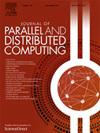迈向超大规模的高速湍流:STREAmS-2 移植与性能
IF 4
3区 计算机科学
Q1 COMPUTER SCIENCE, THEORY & METHODS
引用次数: 0
摘要
超大规模高性能计算(HPC)为推动计算流体力学(CFD)的发展提供了巨大机遇,但尽管使用图形处理器(GPU)已成为大势所趋,可编程性仍是一个问题。STREAmS-2(Bernardini et al.Phys.285 (2023) 108644)是一个用于典型壁界湍流的可压缩求解器,能够充分利用英伟达™(NVIDIA®)图形处理器的潜力。在此,我们使用针对 AMD GPU 架构的新型 HIP 后端扩展了已有的 CUDA Fortran 后端。我们讨论了主要的实施策略,以及一个新颖的 Python 工具,该工具可以生成 HIP 和 CPU 代码版本,使开发人员只需关注 CUDA Fortran 后端。分析的重点是英伟达™(NVIDIA®)A100 和 AMD MI250x 显卡的单 GPU 性能,这些显卡目前是多个高性能计算集群的核心。研究发现,英伟达™(NVIDIA®)显卡的 GPU 峰值性能与 STREAmS-2 性能之间的差距通常较小。通过屋顶线分析,可以追溯到使用这两种显卡的同一内核的计算强度出乎意料地不同。还进行了其他单 GPU 比较,以评估网格大小、并行循环数量、线程屏蔽和线程分歧的影响。并行性能在两个最大的 EuroHPC 预级联系统 LUMI(AMD GPU)和 Leonardo(NVIDIA GPU)上进行了测量。强可扩展性表明,Leonardo 16 节点和 LUMI 32 节点的效率分别超过 80%。弱可扩展性显示,在测试的最大节点数(LUMI 为 256 节点,Leonardo 为 512 节点)范围内,效率超过 95%,令人印象深刻。这项分析表明,STREAmS-2 是充分利用欧洲当前超大规模前 HPC 系统能力的最佳选择,它允许用户模拟超过万亿个网格点的流动,从而缩小了高保真模拟中可实现的雷诺数与实际工程应用中的雷诺数之间的差距。本文章由计算机程序翻译,如有差异,请以英文原文为准。
High-speed turbulent flows towards the exascale: STREAmS-2 porting and performance
Exascale High Performance Computing (HPC) represents a tremendous opportunity to push the boundaries of Computational Fluid Dynamics (CFD), but despite the consolidated trend towards the use of Graphics Processing Units (GPUs), programmability is still an issue. STREAmS-2 (Bernardini et al. Comput. Phys. Commun. 285 (2023) 108644) is a compressible solver for canonical wall-bounded turbulent flows capable of harvesting the potential of NVIDIA GPUs. Here we extend the already available CUDA Fortran backend with a novel HIP backend targeting AMD GPU architectures. The main implementation strategies are discussed along with a novel Python tool that can generate the HIP and CPU code versions allowing developers to focus their attention only on the CUDA Fortran backend. Single GPU performance is analyzed focusing on NVIDIA A100 and AMD MI250x cards which are currently at the core of several HPC clusters. The gap between peak GPU performance and STREAmS-2 performance is found to be generally smaller for NVIDIA cards. Roofline analysis allows tracing this behavior to unexpectedly different computational intensities of the same kernel using the two cards. Additional single-GPU comparisons are performed to assess the impact of grid size, number of parallelized loops, thread masking and thread divergence. Parallel performance is measured on the two largest EuroHPC pre-exascale systems, LUMI (AMD GPUs) and Leonardo (NVIDIA GPUs). Strong scalability reveals more than 80% efficiency up to 16 nodes for Leonardo and up to 32 for LUMI. Weak scalability shows an impressive efficiency of over 95% up to the maximum number of nodes tested (256 for LUMI and 512 for Leonardo). This analysis shows that STREAmS-2 is the perfect candidate to fully exploit the power of current pre-exascale HPC systems in Europe, allowing users to simulate flows with over a trillion mesh points, thus reducing the gap between the Reynolds numbers achievable in high-fidelity simulations and those of real engineering applications.
求助全文
通过发布文献求助,成功后即可免费获取论文全文。
去求助
来源期刊

Journal of Parallel and Distributed Computing
工程技术-计算机:理论方法
CiteScore
10.30
自引率
2.60%
发文量
172
审稿时长
12 months
期刊介绍:
This international journal is directed to researchers, engineers, educators, managers, programmers, and users of computers who have particular interests in parallel processing and/or distributed computing.
The Journal of Parallel and Distributed Computing publishes original research papers and timely review articles on the theory, design, evaluation, and use of parallel and/or distributed computing systems. The journal also features special issues on these topics; again covering the full range from the design to the use of our targeted systems.
 求助内容:
求助内容: 应助结果提醒方式:
应助结果提醒方式:


